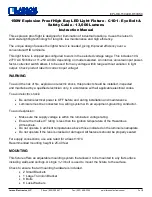
•
increased level of stress associated with everyday activities,
•
disturbances of sensory perception,
•
social interaction and self-acceptation more difficult (depression),
•
increased stigmatisation, stereotypy, discrimination and lack of acceptation among the active members of
the society,
•
reduced effectiveness and possibility of rehabilitation, which leads to secondary aggravation of the
above disorders.
1.3
Advantages Of Dynamic Parapodium
1.
Self-dependent standing up, i.e. assuming upright position and self-dependent sitting up with beneficial forced exercise
of the upper extremities, which, in turn, leads to:
•
Elimination of muscular and articular contractures as well as spasticity,
•
Adequate nutrient supply to the connective tissue,
•
Healing of bedsores,
•
Physiological load of the skeletal and articular system (locomotor system),
•
Physiological function (and location in body cavities) of internal organs (peristaltics of the intestines – bowel
movements, normalisation of the mechanisms of micturition-neurogenic bladder) and others,
•
Normalisation of function of the cardiovascular and respiratory system.
2.
Self-dependent, completely safe and comfortable standing without the necessity to use hands for many hours (even if
the patient loses consciousness the upright position is maintained owing to continuous control of the centre of gravity of
the body).
3.
Self-dependent, completely safe locomotion using the patient’s own muscular strength without the necessity of external
source of energy (external power supply) making full self-service and serving other people possible.
4.
Wide range of rehabilitation together with ergotherapy.
5.
Improving general condition as preparation for practising sports.
6.
Preparation of the organism for use of other systems of orthoses of locomotion aid type helping the patient to walk in
the environment of healthy people.
However, it should be remembered that only assuming upright position itself is associated with additional exertion.
Advantages – the benefits associated with using such orthotic system as the Dynamic Parapodium place it In the
group of exceptionally valuable devices on the world scale.
1.4
Most Common Systemic Disturbances Likely To Occur In Paraplegia
WARNING.
The prerequisite for starting rehabilitation of the patient making use of the Dynamic Parapodium is
previous consultation with the managing physician. After appropriate qualification of the patient, raising his
awareness concerning the possibility of occurrence of certain systemic dysfunctions and giving instructions
what the patient should do in case of such dysfunctions, an individual, preliminary therapeutic programme is
designed, whose aim is gradual adaptation of the organism to the device.
Danger
. Neglecting the above recommendations may lead to natural reaction of the organism to the change of
position of many internal organs, unpleasant for the patient, requiring adaptation to the new conditions.
From our experience it follows that particular attention should be paid to:
1.
Efficiency of the circulatory system
(hypotonia
–
exertion hypotonia, orthostatic hypotonia), because in the cases of
high-located spinal cord damages the course of exercise may lead to paradoxical load on the cardiovascular system
(exertion hypotonia) with congestion of blood in the lower portion of the body and orthostatic hypotonia due to the effect
of gravity. Hypotonia together with reduced cardiac output and cerebral blood flow may cause nausea and vomiting,
vertigo, leading even to the loss of consciousness. Performing preliminary ECG and, if necessary, also USG of the heart
is mandatory. Reduction of the risk of hypotonia is achieved by training – by lifting legs during exercise, regular
orthostatic training (e.g. backward head deflection, assuming upright position on a tilting table, walking aided by
orthoses), appropriate hydration, compression stockings, wide abdominal belt and physical fitness. If the above
mentioned symptoms occur, first aid involves tilting the patient back to facilitate venous return, increase cardiac output
and blood pressure.
2.
Efficiency of the respiratory system
. Spirometric assessment of respiratory efficiency is recommended. Prevention of
ventilation disturbances involves among others maintaining mechanical patency of the bronchial tree (positional
drainage, liquefaction of secretions, preventing bronchial spasms, etc.), increasing tidal volume by training muscles and
teaching the patient to assume appropriate position of the trunk.
4


































